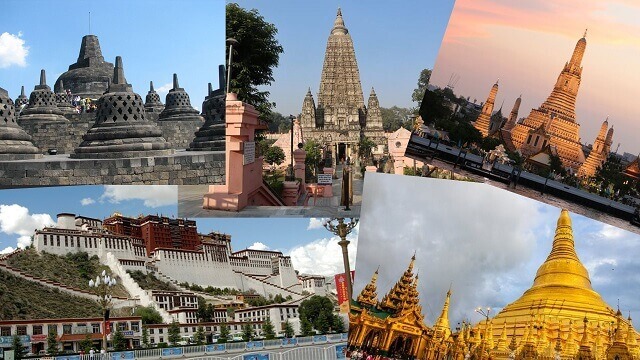Buddhism is a religion that has its origins in ancient India but has since spread throughout the world. Along with its religious teachings, Buddhism has also developed a unique Architectural style reflecting its beliefs and values. In this article, we will explore the origin of Buddhist architecture and how it has evolved.
Buddhist architecture refers to the distinctive style and design of buildings and structures that are associated with Buddhism. It encompasses a wide range of architectural styles, from the ancient rock-cut temples of India to the ornate pagodas of East Asia.
Importance of Buddhist Architecture in Buddhism Culture:
Buddhist architecture holds significant importance in Buddhist culture. As an expression of Buddhist teachings and values, additionally, it reflects the religion’s spiritual and Philosophical outlook. Architecture plays a crucial role in the practice of Buddhism, serving as a place for Meditation, Reflection, and Religious ceremonies.
Buddhist architectures often designed with natural materials such as wood, stone, and brick, representing the Buddhist belief in the interconnectedness of all things in nature. Symbolic elements, such as the lotus flower and the wheel of dharma, reinforces Buddhist teachings and help to create a serene and contemplative environment.
Moreover, the essential features of Buddhist architecture is the open spaces and courtyards incorporated into the design. These spaces are used for Meditation and Reflection, allowing practitioners to connect with nature and their inner selves.
Additionally, the Intricate carvings, decorations, colourful Murals and Frescoes often depict Buddhist stories and teachings. These serve as visual aids to help practitioners understand and internalize these teachings.
Buddhist architecture can also serve as a symbol of a community’s devotion to the religion. Monasteries and temples, in particular, are often built with great care and attention to detail, demonstrating the community’s commitment to Buddhism and providing a focal point for religious life.
Origin of Buddhist Architecture:
The origin of Buddhist architecture can be traced back to the early years of Buddhism when the religion was just starting to spread across the Indian subcontinent. During this time, Buddhist architecture was primarily focused on constructing simple monastic dwellings for the Buddha and his followers.
The earliest Buddhist structures were made of wood and thatch and were designed to be simple and functional. These structures were build in response to the needs of the growing Buddhist community. They were often located in remote areas to facilitate meditation and contemplation.
As Buddhism began to spread throughout India, its architecture became more elaborate and sophisticated. Stupas, or domed structures containing Buddhist relics, were build in honour of the Buddha and other important figures in the religion. These structures were often decorated with intricate carvings and reliefs depicting Buddhist stories and teachings.
In addition to stupas, Buddhist temples and Monasteries were build to serve as places of worship and Meditation. These structures were often in natural settings, such as mountains and forests. They were designed to blend in with their surroundings. Buddhist architecture also incorporated local cultural and traditional elements, Resulting in unique regional styles and variations.
Buddhist architecture continued to evolve throughout Asia as Buddhism spread to new regions. The influence of different cultures and Architectural styles led to further Innovation and Adaptation of Buddhist architecture, resulting in diverse styles and designs.
Early Buddhist Structures:
Early Buddhist structures were primarily simple and functional in design, built in response to the needs of the growing Buddhist community in India during the early years of the religion. These structures were primarily simple and functional, designed for the use of the Buddha and his followers in remote areas to facilitate meditation and contemplation.
These structures were often located in remote areas, such as forests or mountains, to facilitate meditation and contemplation. They were also designed to be easily dismantled and moved, allowing flexibility and mobility as the Buddhist community travelled and spread its teachings.
As Buddhism continued to grow and spread throughout India, so did the complexity and sophistication of its structures. Stupas, or domed structures containing Buddhist relics, were build in honor of the Buddha and other important religious figures. These structures often decorated with intricate carvings and reliefs depicting Buddhist stories and teachings.
Buddhist temples and Monasteries also constructed during this time, serving as places of worship and meditation for Buddhist communities. These structures were often more extensive and elaborate than early Buddhist ones, incorporating architectural elements such as courtyards, multiple rooms, and decorative motifs.
Despite their simplicity, early Buddhist structures played an essential role in developing Buddhist architecture. They laid the foundation for later, more complex structures, and their emphasis on functionality and flexibility reflected the values and teachings of the Buddhist religion.
Stupas: Exploring the Significance and Symbolism of Stupas
Stupas are one of the most prominent forms of Buddhist architecture found in various parts of the world, particularly in countries with a strong Buddhist tradition such as India, Nepal, Sri Lanka, Myanmar, Thailand, and Cambodia.
They are dome-shaped structures found in many parts of the Buddhist world, serving as important monuments to the religion. However, they vary in size and complexity, from simple mounds of earth or stones to elaborately decorated structures adorned with intricate carvings and reliefs. Moreover, the decorative elements of stupas often hold symbolic significance in Buddhist culture.
They serve as important reminders of the Buddhist tradition and its teachings, and as symbols of the enduring legacy of this ancient and venerable religion.
Monasteries: Unveiling the Design and Function of Monasteries
Monasteries play a significant role in preserving and promoting Buddhist teachings and traditions. However, they serve as more than just a physical place for religious practice. Moreover, they serve as a place of refuge for those seeking spiritual guidance, offering opportunities for individuals to deepen their spiritual practice through meditation, chanting, and other rituals.
Monasteries play an essential role in the Buddhist tradition, serving as centres of learning, practice, and community for monks and laypeople, also known as viharas or gompas. Buddhist monasteries are found worldwide, reflecting the diverse cultural and geographic contexts in which the religion has developed.
Monasteries serve several functions, including as centres of education and spiritual practice, as well as places of community life and social connection. They are an essential embodiment of the Buddhist tradition, reflecting its values and teachings in physical form.
Chaitya Griha: The Spiritual Essence of Chaitya Grihas
A Chaitya Griha, also known as a Buddhist rock-cut temple, a sacred space found in ancient Indian architecture, particularly in Buddhist architecture. These structures are carved out of solid rock. They are characterized by their unique horseshoe-shaped windows, ribbed vaulted ceilings, and pillared interiors.
Chaitya Grihas were carved out of rock in the 2nd century BC and are found in various parts of India, particularly in the Western Ghats region. They typically feature a large central hall with a semi-circular apse at one end, which contains a stupa or a Buddha statue.
The walls of the hall are decorated with elaborate carvings and sculptures, depicting scenes from the life of the Buddha and other Buddhist deities. These structures were initially used as places of worship for early Buddhist communities and have remained an essential part of Buddhist architecture.
They are considered some of the most impressive examples of ancient Indian rock-cut architecture and continue to inspire awe and reverence in those who visit them.
Incorporation of Local Cultural Influences in Buddhist Architecture:
Buddhism has a long history of incorporating local cultural influences into its practices and beliefs, including architecture. As Buddhism spread to different regions, it adapted to the local customs, traditions, and materials available. It has led to a rich diversity of Buddhist Architectural styles worldwide.
India:
In India, where Buddhism originated, the architecture reflects the indigenous styles of the time. The earliest Buddhist structures, such as the stupa at Sanchi, were build using local materials such as stone and brick. As Buddhism spread to other parts of Asia, it adopted the region’s architectural styles.
Southeast Asia:
In Southeast Asia, for instance, Buddhist temples often incorporate elements of Hindu architecture, as both religions share a common historical and cultural heritage. For example, the Khmer Empire of Cambodia built massive temple complexes, such as Angkor Wat, that blended Buddhist and Hindu elements. The Burmese style of Buddhist architecture also incorporates elements of Indian and Mon architecture.
East Asia:
In East Asia, Buddhist architecture has influenced by Indigenous Chinese and Japanese styles. Chinese Buddhist temples often have a distinctively Chinese appearance, with curved eaves, bright colors, and intricate carvings. On the other hand, Japanese Buddhist architecture emphasizes simplicity and Elegance, with clean lines and natural materials such as wood and paper.
Tibet:
In Tibet, where Buddhism developed its unique form, the architecture reflects the harsh climate and the need for protection from the elements. The iconic Tibetan Buddhist Monasteries, such as the Potala Palace in Lhasa, are build using local materials such as mud, stone, and wood and often feature flat roofs, thick walls, and narrow windows to keep out the cold.
Key Features of Buddhism Architecture:
Buddhism architecture is characterized by several key features that reflect the religious and Philosophical beliefs of Buddhism. Here are some of the critical features of Buddhist architecture:
The Use of Natural Materials in Buddhist Architecture: Building with Earth, Stone, and Wood
Buddhist architecture emphasizes using natural materials such as wood, stone, and brick. It is because Buddhism greatly emphasizes harmony with nature and avoids harm to living beings. These natural materials also provide a sense of Serenity and Peacefulness essential to Buddhist practice.
Symbolic elements:
Buddhist architecture is rich in symbolic elements that convey the teachings of the Buddha. For example, stupas or pagodas represent the five elements (earth, water, fire, air, and space) and the Eightfold path. The lotus flower symbolizes purity and Enlightenment, while the wheel symbolizes the Buddha’s teachings and the cycle of birth and death.
Open Spaces and Courtyards in Buddhist Architecture: Creating Serene Environments for Meditation and Reflection
Buddhist architecture often features open spaces and Courtyards, allowing contemplation and Meditation. These spaces provide a sense of openness and freedom that encourages Self-reflection and Introspection.
Intricate Carvings and Decorations:
Buddhist architecture also known for its intricate carvings and decorations that adorn temples, stupas, and Monasteries. These carvings often depict scenes from Buddhist Mythology or the life of the Buddha. They are intended to inspire devotion and reverence.
Colourful Murals and Frescoes in Buddhist Architecture: Depicting the Life and Teachings of the Buddha
Another hallmark of Buddhist architecture is the use of colourful murals and Frescoes that adorn temple walls and ceilings. These paintings often depict scenes from the Buddha’s life and other important figures and teachings from Buddhist history.
The critical features of Buddhist architecture reflect the religion’s emphasis on harmony with nature, symbolic elements that convey Buddhist teachings, open spaces for contemplation, intricate carvings and decorations, and colourful murals and Frescoes that inspire devotion and reverence.
Examples of Buddhist Architecture:
Buddhist architecture has been prevalent for thousands of years, and there are countless examples of stunning structures that reflect the principles and beliefs of this ancient religion. Here are a few examples of Buddhist architectures around the world that showcase the unique characteristics and features of this style:
Borobudur Temple, Indonesia:
It is one of the largest Buddhist temples in the world and is famous for its Intricate carvings and reliefs. It is build in the shape of a mandala and features nine stacked platforms, representing the stages of Enlightenment.
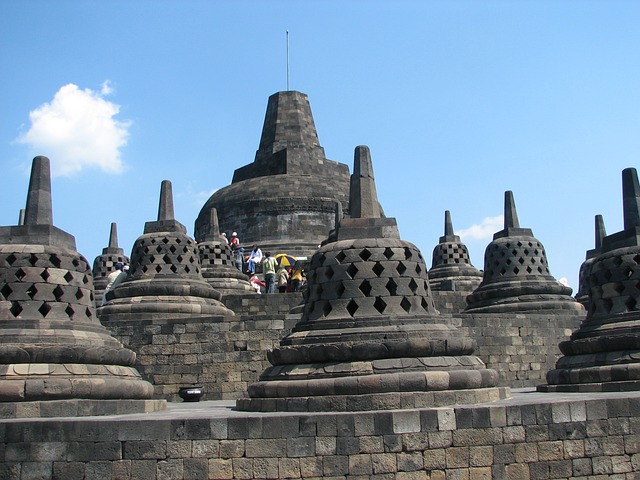
Sanchi Stupa, India:
This ancient structure is one of India’s oldest and most Well-preserved stupas. It features intricate carvings and Sculptures depicting scenes from the Buddha’s life.

Potala Palace – Lhasa, Tibet:
The Potala Palace is a Sprawling complex that was the chief residence of the Dalai Lama until the 14th century. Dalai Lama fled to India during the 1959 Tibetan uprising. The palace was first build in the 7th century and expanded over the centuries. It is considered a masterpiece of Tibetan architecture and is a UNESCO World Heritage Site.

Shwedagon Pagoda – Yangon, Myanmar:
The Shwedagon Pagoda, a sacred site for Buddhists and believed to Enshrine strands of the Buddha’s hair and other relics. The pagoda is covered in gold leaf and is surrounded by smaller pagodas, shrines, and statues. It is considered the most sacred Buddhist pagoda in Myanmar.
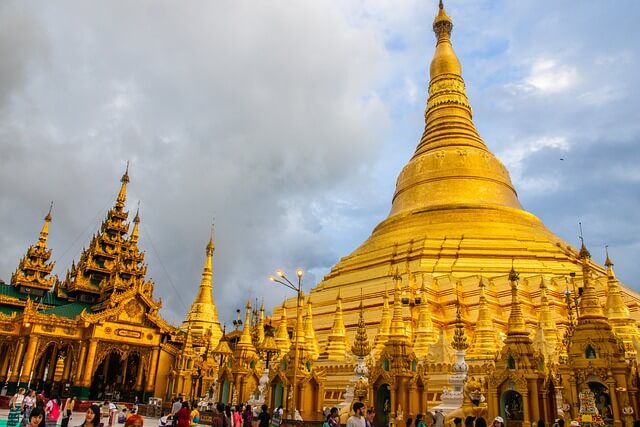
Mahabodhi Temple -Bodh Gaya, India:
The Mahabodhi Temple is believed to be where the Buddha attained Enlightenment. The temple complex consists of a large main temple surrounded by smaller shrines and Meditation gardens. The temple is decorated with Intricate carvings and is a UNESCO World Heritage Site.
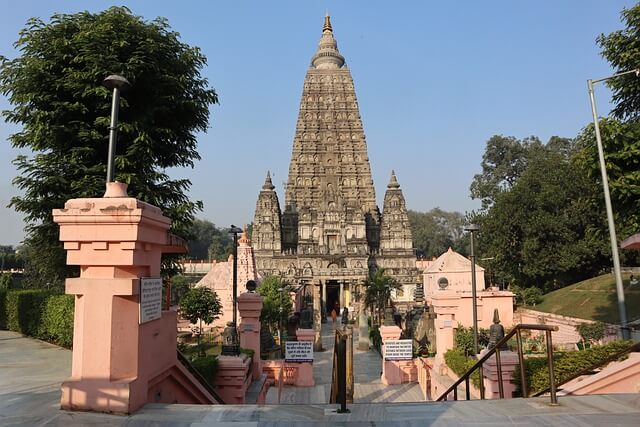
Wat Arun – Bangkok, Thailand:
Wat Arun, a Buddhist temple known for its distinctive Khmer-style tower. The tower is covered in colourful glass and Chinese Porcelain tiles and is decorated with intricate carvings and statues. The temple is located on the bank of the Chao Phraya River and is a popular tourist destination.
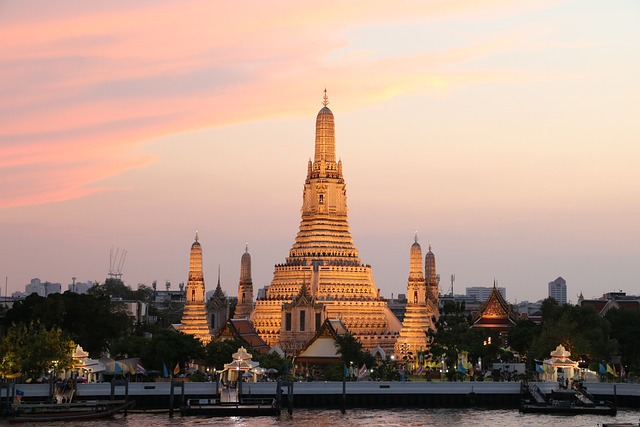
These are just a few examples of the diverse and stunning architecture found in the Buddhist tradition. Each structure is unique and reflects the cultural and artistic traditions of the region in which it was built.
Conclusion:
In conclusion, Buddhism has a rich tradition of architecture that reflects its principles of simplicity, harmony, and detachment from material possessions. Buddhist architecture can be seen in temples, pagodas, stupas, and Monasteries, which are often build in natural settings to enhance the sense of spiritual connection with the environment.
Through its unique blend of Aesthetics, Symbolism, and Functionality, Buddhism has created a distinctive Architectural style that continues to inspire and captivate people worldwide.
For more articles visit: 21Hashtags
